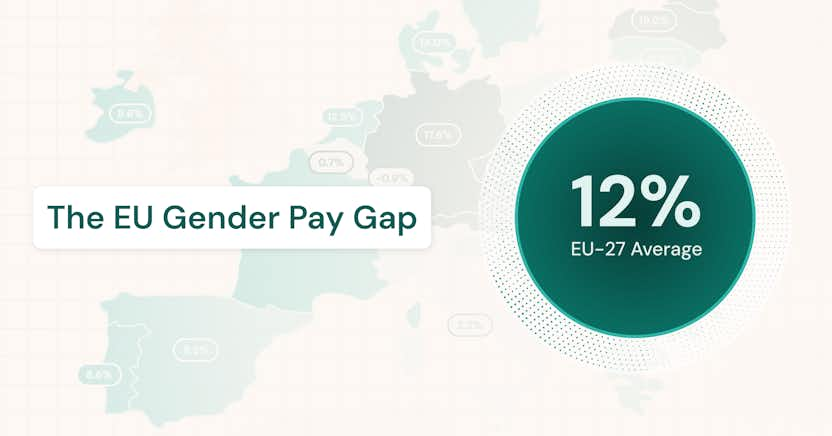How to Identify and Address Pay Disparity and Inequity at Your Company

Learn more about the following beqom products
How to Identify and Address Pay Disparity and Inequity at Your Company
Pay disparity and pay inequity are both prevalent issues that affect employees and employers, causing tension, decreasing productivity, and leading to other negative outcomes.
Although pay disparity is not illegal, it can cause long-term damage to a business’s retention rates and reputation. In fact, only 55% of US employees believe their company pays them fairly, and while the gender pay gap has narrowed over recent years, it has not closed completely.
Organizations must actively identify and adjust pay disparity before it evolves into pay inequity, which is illegal and violates US anti-discrimination laws.
Discover how to identify and address pay disparity within your organization to establish a fair and transparent compensation system that can boost employee morale, build trust, and improve overall workplace productivity.
The difference between pay disparity and pay inequity
Before exploring and addressing these issues, organizations must recognize the distinct differences between pay disparity and pay inequity.
Pay disparity
Pay disparity refers to the differences in wages or salaries between different groups of workers, which can be based on various factors such as gender, race, ethnicity, job role, or industry. It highlights the existence of significant gaps in earnings among employees who may perform similar tasks or hold similar positions.
Pay inequity
Pay inequity, on the other hand, refers to the unfair or unjust distribution of pay among workers. It is often used to describe situations where the differences in pay cannot be justified by legitimate factors such as experience, education, or job performance, but are instead influenced by discriminatory practices or biases.
Pay inequity is a serious issue that can leave businesses susceptible to discrimination lawsuits, reduce their retention rates, and severely damage their reputation. Organizations in the US and Europe must consider the importance of pay equity and integrate HR technology and practices to manage it.
Relationship between pay disparity and pay inequity
How do pay disparity and pay inequity relate?
- Pay disparity can be a result of pay inequity. When pay disparities arise from unjust or discriminatory practices, they constitute pay inequity.
- Pay disparity highlights the observable differences in earnings, while pay inequity focuses on the fairness and justice of these differences.
- Addressing pay inequity involves identifying and correcting the underlying causes of pay disparities to ensure that all employees receive fair compensation for their work.
In essence, while pay disparity measures the gap itself, pay inequity examines the fairness and causes behind that gap.
Why worry about pay disparity?
Pay disparity can be a symptom of several underlying issues in an organization, including:
1. Systemic discrimination: Pay disparities may reflect broader systemic issues such as gender, racial, or other forms of discrimination that affect hiring, promotion, and compensation practices.
2. Lack of transparent pay policies: When compensation policies are not transparent, it can lead to inconsistencies and unfair pay practices. Employees might not understand how pay decisions are made, leading to disparities.
3. Unconscious bias: Unintentional biases in decision-making processes can result in unequal pay for similar roles. This can occur during hiring, performance reviews, and promotion processes.
4. Inconsistent performance evaluation: If performance evaluations are not standardized or objective, they can lead to pay disparities. Favoritism or subjective judgments can skew compensation.
5. Ineffective pay structures: Outdated or poorly designed pay structures may not adequately reflect the value of different roles within the organization, leading to unequal pay for comparable work.
6. Lack of diversity and inclusion initiatives: Organizations that do not prioritize diversity and inclusion may inadvertently perpetuate pay disparities by failing to address the unique challenges faced by underrepresented groups.
7. Insufficient data analysis: Without regular analysis of compensation data, organizations may overlook existing pay disparities and the factors contributing to them. This can prevent timely identification and correction of inequities.
8. Cultural issues: Organizational culture that does not emphasize fairness and equity can contribute to pay disparities. A culture that tolerates or overlooks discrimination and bias will likely exhibit pay inequities.
9. Weak HR practices: Ineffective human resources practices, such as poor onboarding, lack of training on bias, and inadequate support for career development, can contribute to pay disparities.
10. Market misalignment: Failure to regularly benchmark salaries against industry standards can result in pay disparities. Some employees might be underpaid relative to the market, while others might be overpaid.
Addressing these underlying issues requires a multifaceted approach, including implementing fair and transparent pay policies, conducting regular pay audits, providing bias training, promoting diversity and inclusion, and ensuring that performance evaluations are objective and consistent.
The benefits of reducing pay disparity
Since pay disparity can be a leading indicator of other issues, taking action to reduce it can prove to be highly beneficial for organizations. The key advantages of lowering pay disparity include:
- Increased retention rates: As reducing pay disparity promotes fairness and equality, employees are more likely to feel satisfied, valued, and respected, encouraging them to continue working for the organization rather than seeking other opportunities.
- Attraction of new employees: The attractiveness of an organization to prospective employees will increase when pay disparity is reduced, leading to a larger and more diverse pool of applicants, allowing the organization to hire top talent within its industry.
- Improved productivity: When employees feel like they are being fairly compensated for their work, they will be motivated to become more engaged in it, leading to a highly productive workforce.
- Built trust: Reducing pay disparity can build employee confidence and ensure their faith in the organization’s leadership and decision-making process. As a result, management can build stronger relationships with employees, creating a positive and supportive work environment.
- Enhanced reputation: When public members perceive that an organization values fairness, equity, and ethical business practices, they will be more inclined to support their products or services and engage positively with the brand, increasing its reputation.
How to identify pay disparity and pay inequity
Organizations can recognize instances of pay disparity or pay inequity by gathering and analyzing relevant data across different employees, job roles, and departments.
Gathering data
Organizations should begin with a pay equity audit to assess their compensation practices and identify discrepancies. Typically, HR departments will assume leadership during this process, but organizations may also refer to legal counsel to ensure they are complying with state and federal laws.
The audit typically involves collecting data related to employee compensation, including salaries, bonuses, commissions, and other forms of compensation, as well as demographic information such as gender, race, ethnicity, age, and job title. This data can be obtained from relevant sources such as payroll records and performance evaluations.
Analyzing data
Once the data has been collected, it should be analyzed to identify any patterns or inconsistencies in compensation that may indicate pay disparity or inequity. This analysis may involve comparing salaries within similar job roles and measuring pay gaps between different demographics to determine if any consistently receive lower salaries. Workforce Analytics software can significantly aid this process, providing organizations with data and insights to identify employees at risk of unexplained pay gaps and prevent future gaps or biased decisions.
How to address pay disparity and pay inequity
To address pay disparity and inequity, organizations are advised to complete a four-step process that determines the issues’ root causes, encourages discussions with employees, implements targeted initiatives, and establishes systems for ongoing monitoring and evaluation.
1. Investigate root causes
After identifying instances of pay disparity and pay inequity, organizations must explore the root causes and key contributing factors before attempting to correct these issues.
For instance, pay disparity and inequity can often stem from the recruiting and interviewing processes. Hiring managers may offer candidates lower salaries due to unconscious biases or a lack of transparency. If an organization does not have a clear compensation structure before recruiting new applicants, subjective decision-making from hiring managers can cause significant disparities in pay offers.
This can lead to inconsistencies and favoritism, where candidates with similar qualifications and experiences may receive different salary offers based on hiring managers’ arbitrary judgments or personal preferences. Similarly, salary negotiation processes may also disadvantage certain groups who are less likely to negotiate for higher compensation.
After assessing the root causes of pay disparity and pay inequity, organizations can take a structured approach to effectively allocate remedial resources and close wage gaps.
2. Communicate with employees
After identifying the root causes of disparities and inequities, organizations are advised to communicate their goals with employees. Open communication can foster trust across the organization and demonstrate its commitment to addressing issues that may negatively impact employees.
Employees should be informed about the steps being taken to rectify pay gaps and promote equity within the organization. This includes sharing information about the findings from the root cause analysis, the strategies being implemented to address systemic biases, and the expected outcomes of these initiatives. Organizations should also provide opportunities for employees to offer feedback, ask questions, and express concerns regarding this process.
3. Implement pay equity initiatives
To be successful, pay equity initiatives require the collaboration of legal teams, finance departments, and HR departments.
One of the first measures organizations can take is providing ongoing training for employees, such as hiring managers, on topics related to unconscious biases, equality, and diversity. This helps raise awareness of potential biases and allows organizations to engage in fair compensation practices. Implementing salary bands can also reduce pay disparity and inequity, as these pay ranges will be established based on market values and other data to ensure all jobs with similar work requirements are grouped within a similar salary range.
Introducing flexible working arrangements may also help to address pay disparity and pay inequity, particularly concerning gender wage gaps. This initiative enables women to reconcile their work and caring responsibilities, allowing them to stay within their roles while still fulfilling other necessary duties. With flexible working, women will likely have more opportunities to advance in their roles and receive promotions or salary increases, which can narrow the organization’s pay gaps. Flexible working arrangements also allow men to equally share caring responsibilities with their partners, which can further support women’s career progression.
Organizations may encounter various challenges and undergo a process of trial and error when addressing pay disparity and pay equity. In some cases, setting DEI goals (Diversity, Equity, and Inclusion) that are specific, measurable, achievable, relevant, and time-bound (SMART) can aid this process and provide organizations with a clear roadmap for making progress.
4. Continuously evaluate progress
After implementing pay equity software, organizations must pay close attention to their progress and be prepared to tackle any challenges or setbacks. After regular evaluations, organizations can improve their initiatives to further eliminate disparities and establish a reputation as a forward-thinking, equitable, and inclusive employer.
Conclusion
To conclude, pay disparity, although often unintentional, can negatively impact employees and their organizations. Decreased productivity, low retention rates, and damaged reputations are some of the most common consequences of pay disparity. If left unchecked, pay disparity can evolve into pay inequity, potentially leaving organizations vulnerable to legal implications.
After identifying instances of pay disparity and inequity through gathering and analyzing relevant data, organizations can begin assessing potential root causes and implement rectification measures wherever necessary. Although addressing pay disparity and inequity is an ongoing progress that should be constantly evaluated and refined, every step a business takes towards equality can leave a lasting, positive impact on its workforce, culture, and reputation.
For information on how the right compensation technology can help you to achieve and sustain fair pay in your organization, get in contact with the experts at beqom.
FAQs
Gain more insight into pay disparity, equality, and inequity with these answers to common questions.
What is the meaning of pay disparity?
Pay disparity is the difference in wages or salaries between different groups of employees within an organization, often highlighting inequities based on factors like gender, race, or job role.
What is the meaning of pay equality?
Pay equality occurs when all employees, regardless of gender or other protected characteristics, receive equal compensation for equal or equivalent work.
How do you approach pay inequity?
Organizations can approach pay inequity by utilizing pay equity software to identify justified and unjustified pay gaps. After collecting data, organizations can find the root causes of inequity and implement targeted HR measures to address them. This may include reassessing compensation structures, providing training to minimize bias in decision-making, and promoting transparency regarding their pay and promotion policies.







